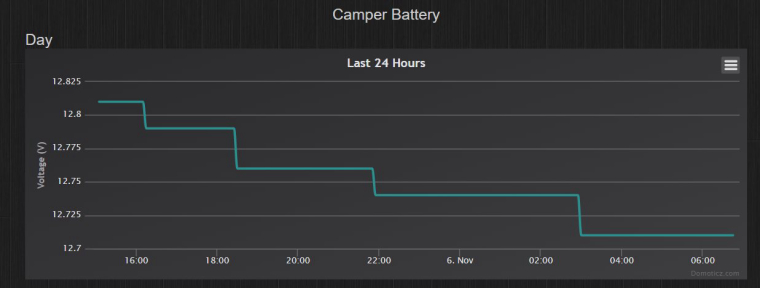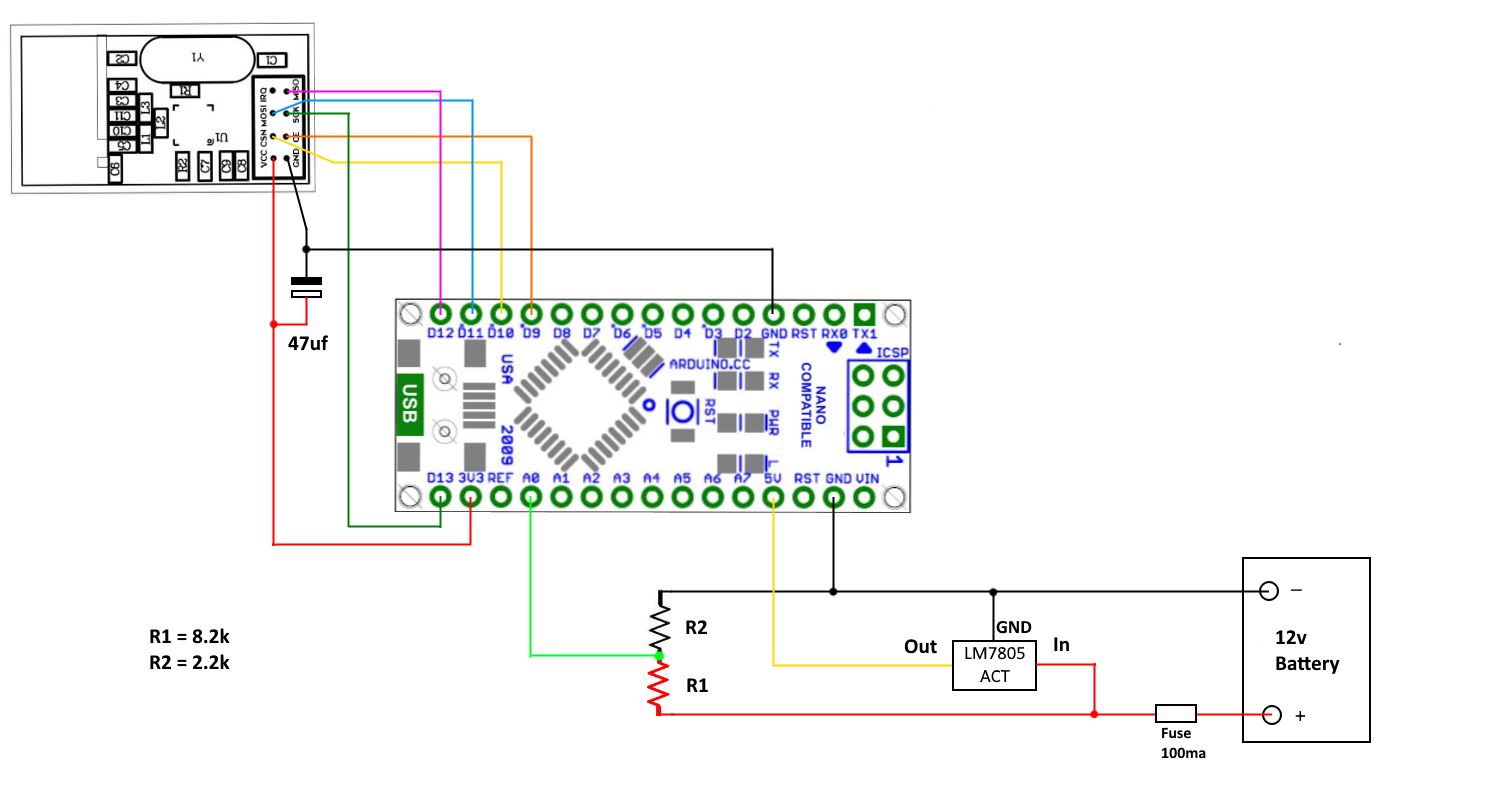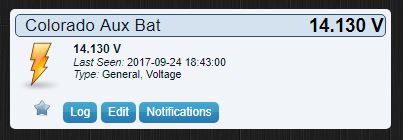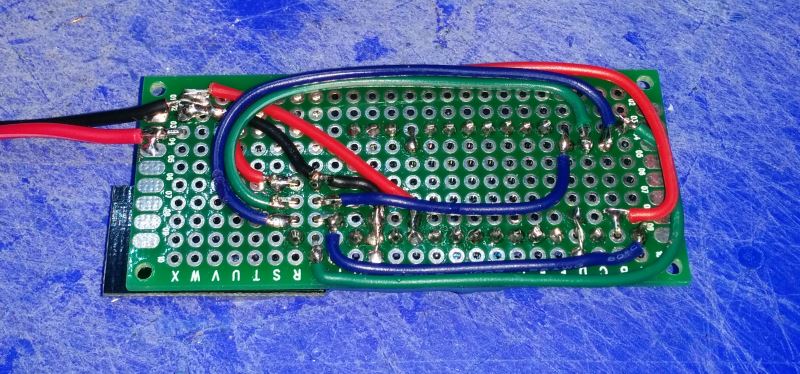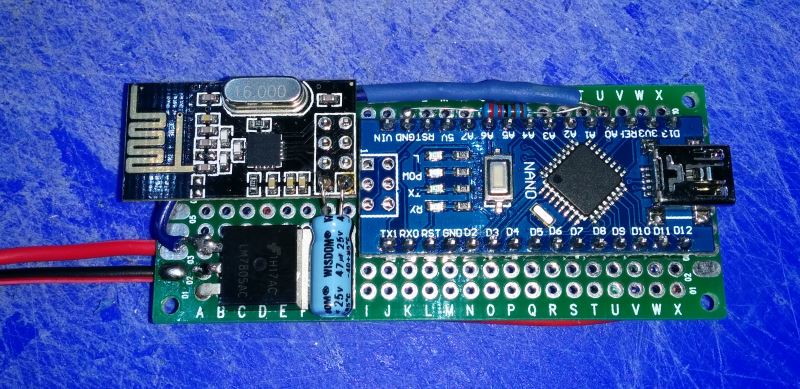Car Aux Battery Monitor
-
I have built a low power version today based on a 3v pro mini board and am so far very happy with the results.
On the pro mini the power LED needs to be disabled and the onboard regulator has to be removed. I followed the instructions on this page
To keep power draw down I have used much higher resistors for the voltage divider and have also included a capacitor to help keep it stable. In testing on the bench it has been very stable.
I have used an easy/newbie board from @sundberg84 which really did make the whole thing very easy :) It even already has the voltage divider layout taken care of. Thank you very much!!
I had to make two minor mods to the board to accommodate the modified pro mini as shown below. Please note these changes are for Rev8 boards so different changes may be needed for other revisions. Rev9 definitely has had changes made to the power area.
The original version from my first post draws around 9ma when sleeping which is ok for my daily drive vehicle. This lower power version is way better for my camper. In testing on the bench these are the typical current requirements.
Booting up .......... 19ma Pretty high but this is only for a few seconds
Powered up and awake....... 4.8ma That's nearly half of the original when it was sleeping
powered up and sleeping ...... 90ua Bingo, this puppy should go for a while on my 200ah batteries ;)So the original draws 0.009A and this new version a miserly 0.00009A a very good result for long term monitoring.
I have modified the Sketch to suit the new node, the main change has been to add 10 reads and average the results to help keep it all stable.
You can see from the serial data the node wakes, takes the reading, sends the data and is back to sleep in less than a blink of the eye! (this was only sleeping for 15 seconds during testing)
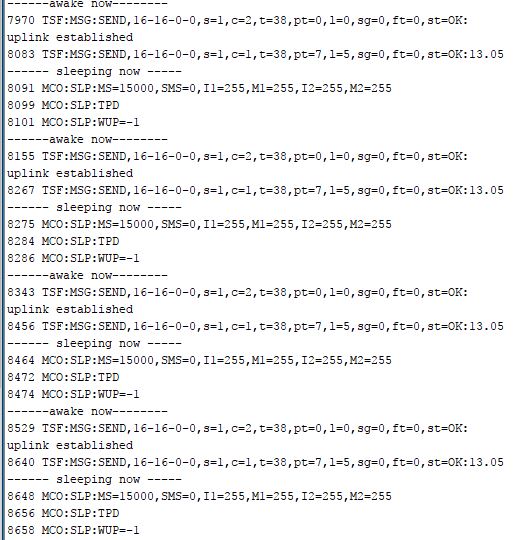
I have used a Rev8 Easy/Newbie board
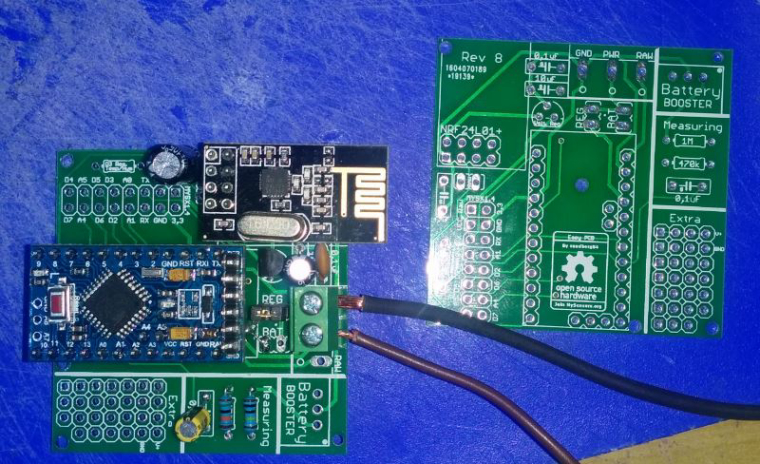
with a couple of tweaks
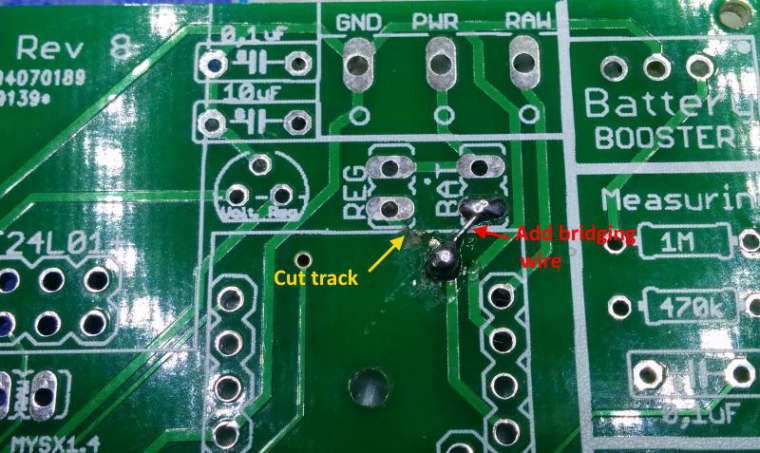
The circuit now looks something like this
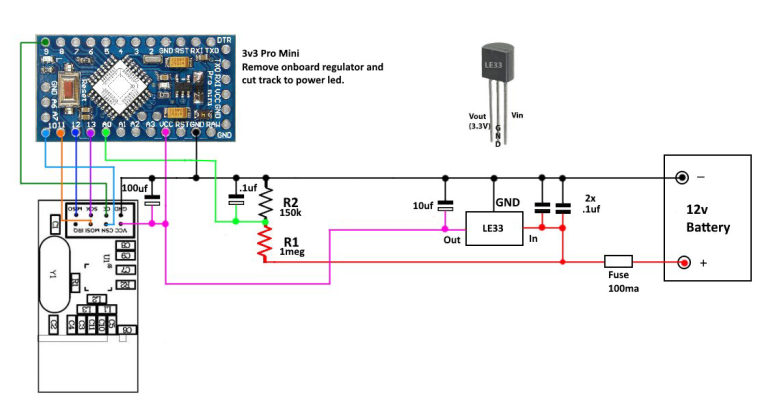
And finally the sketch
/*Sketch for a MySensor node to monitor a 12v aux battery in a Camper Trailer * The node monitors battery voltage and reports back to the controller. Uses a 3v * Pro mini with power led and voltage regulator removed. * Voltage divider R1 1 megaohm R2 150 kilohms * */ #define MY_DEBUG // Enable debug prints to serial monitor #define MY_RADIO_NRF24 // Enable and select radio type attached #define MY_TRANSPORT_WAIT_READY_MS 3000 //set how long to wait for connection to establish before moving on. in milliseconds //#define MY_NODE_ID 15 #define MY_RF24_CHANNEL 84 // set channel used //#define MY_PARENT_NODE_ID 1 // set the parent node //#define MY_PARENT_NODE_IS_STATIC // force connection to parent node only. #include "MySensors.h" #define ID_S_MULTIMETERV 1 // Multimeter device for voltage measurement //unsigned long sleepTime = 15000; unsigned long sleepTime = 60000 * 30; // Sleep time between reads (in milliseconds) (Set to 30 min at present) int voltagePin = A0; // analog pin voltage sensor or voltage divider is connected to int voltSenseMax = 25000; // set to the maximum voltage in millivolts of your voltage divider input int sampleCount = 0; int sum = 0; // sum of samples taken int numSamples = 10; MyMessage msg_S_MULTIMETERv(ID_S_MULTIMETERV,V_VOLTAGE); void setup() { wait (5000); // give node a chance to fully boot on startup } void presentation() { sendSketchInfo("Camper Battery Sensor", "1.0"); // Send the sketch version information to the gateway and Controller present(ID_S_MULTIMETERV, S_MULTIMETER,"Camper Battery"); // Register Sensor to gateway } void loop() { uplinkCheck(); // call function to send data Serial.println("------ sleeping now ----- "); sleep(sleepTime); // sleep until next scheduled check Serial.println("------awake now--------"); wait (50); // small wait to allow to stabalise after sleep. } /*-------------------start of functions--------------------------*/ void uplinkCheck() { if (request( ID_S_MULTIMETERV, V_VOLTAGE)) { // request the current voltage data from the controller and check that the request was succsessful Serial.println("uplink established"); while (sampleCount < numSamples) { sum += analogRead(voltagePin); sampleCount++; delay(10); } int voltMilli = map((sum / 10),0,1023,0,voltSenseMax); // map the reading and get the result in millivolts send(msg_S_MULTIMETERv.set(voltMilli / 1000.0, 2)); // Divide by 1000 to convert back to volts to two decimal places, send data to controller. // send voltage message to gateway with 1 decimal place sampleCount = 0; sum = 0; } else{ Serial.println(" No uplink "); } } -
I was looking at how I would install this node in the camper and decided a permanent mounting might not be the best way to go. The camper is of fully steel construction and because it is meant for off road use when it is packed up it is sealed air tight to prevent water and dust from gaining entry. So this could make it difficult for the signal to get out.
Add to this that the camper is stored in a steel garage and located around 30m from the nearest repeater which is inside the house. So i decided to make the node an external plug in accessory to give it the best chance of making a connection.
The camper already has a heavy lead running directly from the batteries to the front of the A frame. This is used to supply power to the camper while travelling and also allows a solar panel to be connected.
So this seemed like the best spot to connect the node. The lead is fitted with an Anderson plug so connecting up would be easy as well. i hoped that by putting the node on the outside of the camper I would be able to get a stable connection back to the repeater.
The node was mounted into a small length of 50mm pvc tube, the easy/newbie board is a good fit.
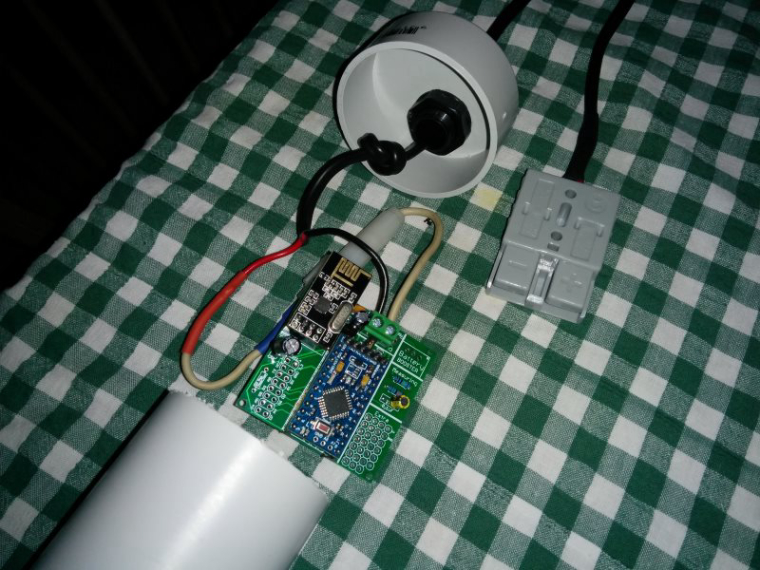
I have fitted a small length of cable with an Anderson plug, this allows a quick connect to the camper electricals. The finished node looks like this.

Then it just plugs into the camper. I found that it can hang over the front winch mount, this allows the body of the node to swing free away from other metal objects.
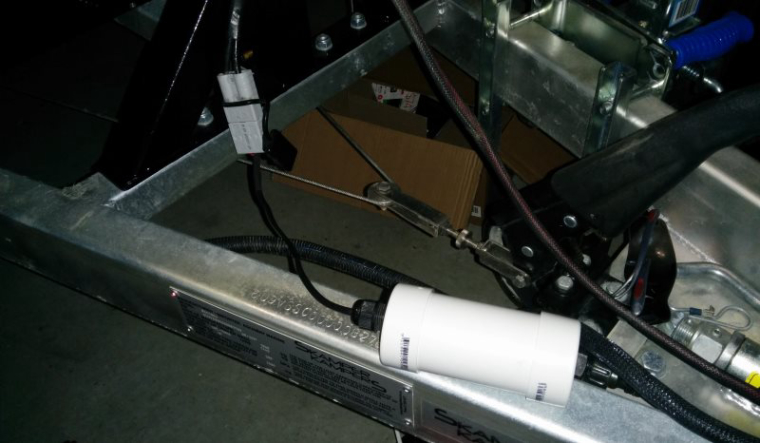
In testing i have the node transmitting every 15 min to get an idea of how it all goes. Unfortunately at the moment it sometimes misses the occasional send so it must be on the edge of range at the moment. Although it is not really critical that it makes connection every time i will have to see what else I can do to make it more reliable.
-
The low power node has continued to be unreliable, connecting only intermittently with the controller. It appears to be a power problem as the node works well when it is powered through the ftdi adaptor.
Voltage readings on the 3v line read 3.4v when on the ftdi and 3.27v through the LE33. Perhaps the LE33 at 100ma cannot keep up with the required demand?
I have added another 47uf capacitor to the nrf supply and that seems to have improved things, so to continue testing I have now installed this unit into my Colorado as well . This will give it the same workout of coming and going that the other node gets and I will be able to compare their readings side by side to see if the voltage averaging this nodes uses makes any difference to reading stability.
-
The low power node has continued to be unreliable, connecting only intermittently with the controller. It appears to be a power problem as the node works well when it is powered through the ftdi adaptor.
Voltage readings on the 3v line read 3.4v when on the ftdi and 3.27v through the LE33. Perhaps the LE33 at 100ma cannot keep up with the required demand?
I have added another 47uf capacitor to the nrf supply and that seems to have improved things, so to continue testing I have now installed this unit into my Colorado as well . This will give it the same workout of coming and going that the other node gets and I will be able to compare their readings side by side to see if the voltage averaging this nodes uses makes any difference to reading stability.
@Boots33 - Im having a hard time to see exact caps on your voltage regulator. A double 0,1 (before) and 10uF (after) could improve the stability of the LE33.
Good thinking about the 47uF on the radio. Sometimes a 4.7 and sometimes 47uF does the job for me.
-
@Boots33 - Im having a hard time to see exact caps on your voltage regulator. A double 0,1 (before) and 10uF (after) could improve the stability of the LE33.
Good thinking about the 47uF on the radio. Sometimes a 4.7 and sometimes 47uF does the job for me.
@sundberg84 Thanks . I have a 0.1 and 10 on the reg at the moment . I will add another 0.1 and see if that helps.
I always used 4.7 on the nrf but since 2.1.1 I find 47uf works best for me now, although in this case it appears that closer to 100uf is what is needed for this node.
-
I was looking at how I would install this node in the camper and decided a permanent mounting might not be the best way to go. The camper is of fully steel construction and because it is meant for off road use when it is packed up it is sealed air tight to prevent water and dust from gaining entry. So this could make it difficult for the signal to get out.
Add to this that the camper is stored in a steel garage and located around 30m from the nearest repeater which is inside the house. So i decided to make the node an external plug in accessory to give it the best chance of making a connection.
The camper already has a heavy lead running directly from the batteries to the front of the A frame. This is used to supply power to the camper while travelling and also allows a solar panel to be connected.
So this seemed like the best spot to connect the node. The lead is fitted with an Anderson plug so connecting up would be easy as well. i hoped that by putting the node on the outside of the camper I would be able to get a stable connection back to the repeater.
The node was mounted into a small length of 50mm pvc tube, the easy/newbie board is a good fit.

I have fitted a small length of cable with an Anderson plug, this allows a quick connect to the camper electricals. The finished node looks like this.

Then it just plugs into the camper. I found that it can hang over the front winch mount, this allows the body of the node to swing free away from other metal objects.

In testing i have the node transmitting every 15 min to get an idea of how it all goes. Unfortunately at the moment it sometimes misses the occasional send so it must be on the edge of range at the moment. Although it is not really critical that it makes connection every time i will have to see what else I can do to make it more reliable.
-
@Boots33 For the radio, what if you used an NRF24L01+PA+LNA with an external antenna. you could put rubber washers on it to keep dirt out while having the antenna external to the other electronics.
Just a thought.
@dbemowsk an external antenna is a good idea. I would like to avoid an amplified nrf if I could though simply because the le33 probably wouldn't cope.
Has anyone fitted an antenna socket to a standard nrf before.
I am happy enough with plugging in the unit at the moment but am also thinking of adding a few more features that will be useful when away. Then it would be better to have a mounted unit. -
@dbemowsk an external antenna is a good idea. I would like to avoid an amplified nrf if I could though simply because the le33 probably wouldn't cope.
Has anyone fitted an antenna socket to a standard nrf before.
I am happy enough with plugging in the unit at the moment but am also thinking of adding a few more features that will be useful when away. Then it would be better to have a mounted unit.@Boots33 there are versions with SMA connector that don't have the PA part ;)
I have also sometimes modified a "standard" NRF24L01+ module with a IPX connector
-
@Boots33 there are versions with SMA connector that don't have the PA part ;)
I have also sometimes modified a "standard" NRF24L01+ module with a IPX connector
Thanks @korttoma didn't know about those, have ordered a couple to give them a try. :)
They will come in handy if I decide to add further to this node and make it a permanent mount.
The camper has a control panel that includes an ammeter and volt gauge to help monitor the batteries, it is pretty basic but does a good job for what it is. It uses a shunt (75mv 100A) for the ammeter so I should be able to tap into that and add current draw to my data.
It also has a fridge box which has little ventilation at the moment so the fridge has to work hard in the hotter weather. We will be travelling into some desert areas next year so a temperature controlled ventilation system may be of use.
All just ideas at the moment will see how it progresses.
The control panel
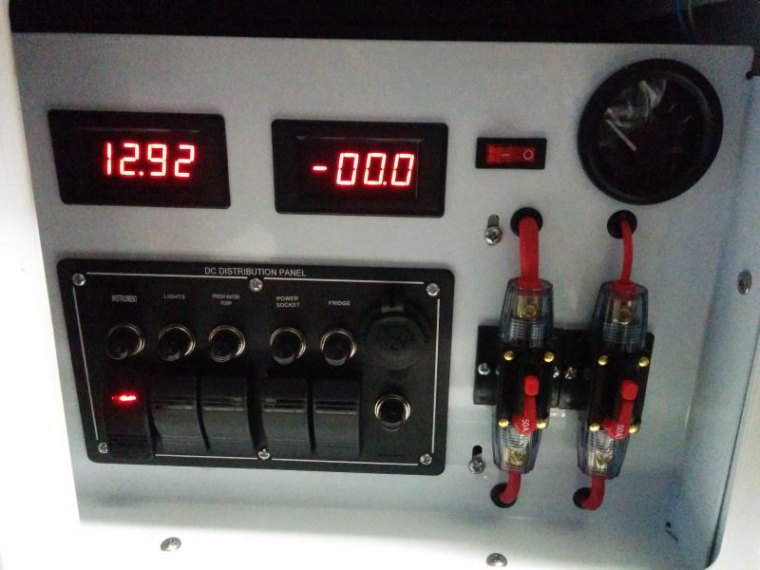
The shunt is mounted on the rear of the panel
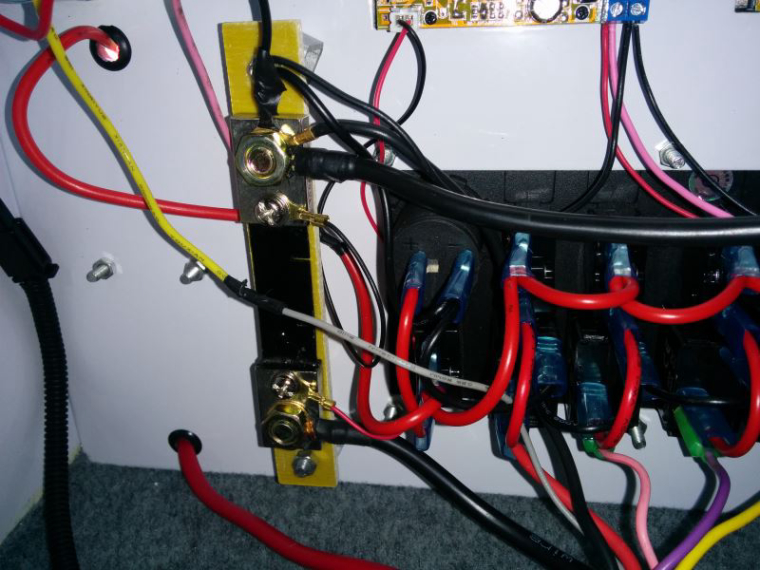
-
The low power node is now working as intended, the addition of an extra 47uf for the nrf power pin (there are two there now so a total of near 100uf) and an aditional .1uf on the LE33 power pin has made the node stable. It shows just how fussy the nrf can be about its power requirements.
I have made the changes to the wiring diagram in the previous post to reflect these additions.
Have also now had a chance to compare the graphs of the two nodes in Domoticz and the low powered node with voltage averaging seems to give a much better result. In the following pictures you can see the steady drop of voltage over time for the low power node and a more zigzag line for the original node.
Will not know for sure until I add averaging to the first node, maybe the extra power draw is also affecting the reading.
The original node
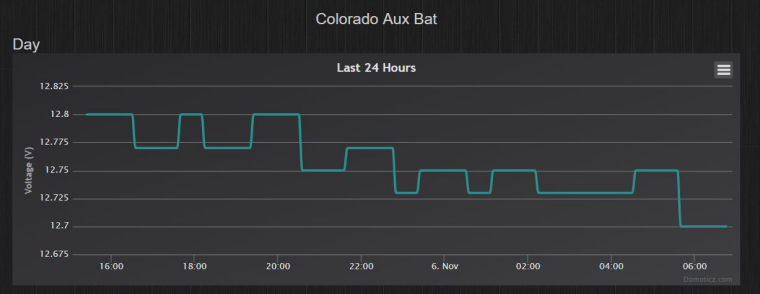
The low powered node. These are both connected to the same vehicle at the moment.
